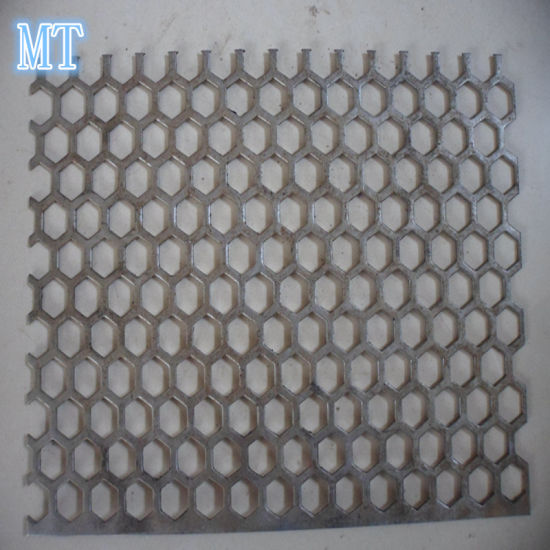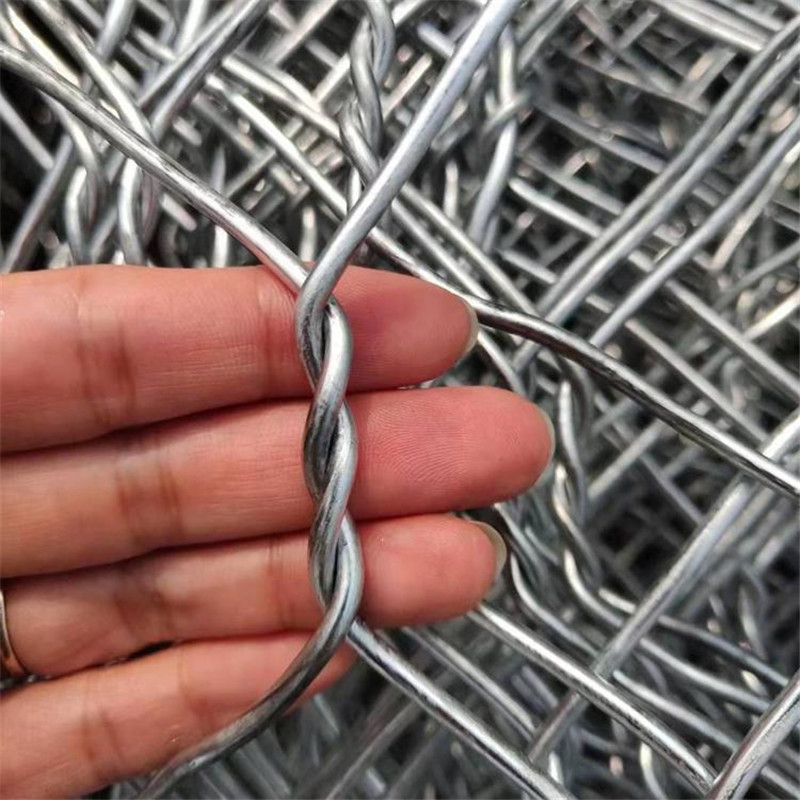By Katie Flannery | Published Sep 18, 2023 2:06 PM
We may earn revenue from the products available on this page and participate in affiliate programs. Square Perforated Metal

When it comes to choosing between chain-link and wood fencing for a property, one of the most important factors for homeowners to consider is cost. Understanding the cost implications of these two popular fence materials can help homeowners make an informed decision that suits their budget and their needs.
Chain-link fencing is known for its affordability. The materials, typically galvanized steel or aluminum with an option to be coated in vinyl, are relatively inexpensive compared to wood. Chain-link fence installation is also usually more straightforward and less labor-intensive, which reduces the overall cost. Maintenance costs for chain-link fences are relatively low as well, with occasional chain-link fence repair being the primary expense over time.
It’s important to note, however, that a chain-link fence often lacks the privacy and aesthetic appeal that a wooden fence offers. If homeowners value privacy and want a fence that blends seamlessly with the surrounding property, they may need to explore options for enhancing chain-link fence privacy, such as adding privacy slats, planting vines along the fence, or paying the cost for a privacy fence.
Wooden fences provide a warm and natural look to any property. Wood fence installation costs are higher than for chain link due to the price of the materials and the labor involved in construction. Wood fence repair may also be needed over the years, since wood is susceptible to rot, insect damage, and weathering. However, the versatility and customization options of wood fencing make it a popular choice for homeowners looking to create a visually appealing and private outdoor space.
The chain-link vs. wood fence cost debate largely depends on a homeowner’s priorities. If budget-friendliness and low maintenance are the primary concerns, chain-link fencing might be the better choice. On the other hand, if the homeowner is willing to invest more up front for a fence that offers privacy and enhances the surrounding property, a wood fence is worth considering. Ultimately, the homeowner will want to consider their needs and preferences to ensure they’re satisfied with their choice. If needed, a seasoned fence installation expert can help explain the homeowner’s options.
Chain-link fencing is generally more cost-effective to install and maintain than wood fencing. The cost advantages of installing a chain-link metal fence stem from several factors. The materials used for chain-link fences are more affordable, and the cheaper material cost translates into a lower initial installation cost. The cost of chain-link fence installation ranges from $1,159 to $3,022, with the national average at $2,090. Labor costs can run from $7 to $15 per linear foot. Compared to other fence materials, chain link is a budget-friendly option, and depending on the outdoor space, it can even be installed by a homeowner if they research how to install a chain-link fence.
Chain-link fence installation is typically quicker and requires less labor than wooden fence construction. Wooden fence installation involves digging holes, setting posts, and attaching individual pickets or panels, which is a more time-consuming and labor-intensive process. The cost of a wood fence ranges from $1,763 to $4,416, with many homeowners spending $3,065. With rates that range between $17 and $45 per linear foot, labor costs to install a wood fence are higher than the labor costs to install a chain-link option.
Chain-link fences also tend to have lower maintenance costs over time. They are durable and resistant to rot, termites, and weathering, which are common issues with wood. While repairs may be needed for issues like damaged chain-link sections or posts, these repairs are usually less expensive and less frequent than the maintenance required for wooden fences, which can include staining, sealing, or replacing individual boards.
Wooden fences offer durability advantages over chain-link fences, potentially resulting in fewer fence repair costs over time. One reason is that wood fences can withstand impacts better than chain-link fences. If a heavy object or strong force hits a chain-link fence, it can bend or become damaged more easily than a wooden fence. The durability of wood can reduce the need for repairs due to accidental damage. Wooden fences also offer greater customization options, allowing homeowners to choose the type of wood, stain or paint color, and design. This customization can result in a fence that perfectly suits their preferences and needs, potentially reducing the likelihood of homeowners wanting to replace or update the fence in the future.
Proper maintenance is key to maximizing the durability of wooden fences. Neglected wood fences can develop issues like rot, warping, or insect infestations, which can lead to costly repairs or replacement. Knowing how to fix a leaning fence can help homeowners keep repair costs down over time. Homeowners will want to be prepared to invest time and effort in maintaining their wooden fences to enjoy their long-lasting benefits.
Wood fences demand regular maintenance to extend their lifespan, which can result in higher long-term costs than the costs for chain-link fences. There are several maintenance considerations for wood fences.
In contrast, chain-link fences generally have lower maintenance requirements. They are resistant to issues like rot and insect damage, and their materials are durable and require minimal upkeep. While wood fences offer durability and design advantages, it’s important for homeowners to factor in the ongoing maintenance costs when making a decision.
Need help choosing a fence material?A top-rated local pro can help. Get free, no-commitment project estimates from fence installers near you. Find Pros Now +
Wood fences are vulnerable to various issues that chain link fences are not. These include pest damage, rot, and mold and mildew; proper maintenance can help prevent these issues to some extent, but homeowners will need to include upkeep in their budget.
To mitigate these potential problems, regular maintenance is essential for wooden fences. This maintenance includes staining or sealing to protect against moisture and pests, inspecting for signs of damage, and promptly addressing any issues that arise. While these maintenance tasks incur additional costs and require time and effort, they are crucial for prolonging the life of a wood fence. In contrast, chain-link fences are less susceptible to these issues, which can make them a more appealing choice for homeowners who prefer a low-maintenance fencing option, even though they have their own set of considerations.
Homeowners will want to note that the lifespan of a chain-link fence compared to that of a wood fence can vary depending on several factors, including the quality of materials, climate, and maintenance. Chain-link fences have a lifespan of 20 years, while wood fences last about 15 years. The longer lifespan of a chain-link fence can potentially delay the need for replacement and reduce long-term costs.
It’s possible for a well-maintained chain-link fence to have a slightly longer lifespan than a wood fence, which may reduce the need for replacement in the short to medium term. It’s important that homeowners weigh this potential advantage against other factors such as privacy, aesthetics, and up-front costs when deciding between the two fence types.
Pick the perfect fence with the help of a proGet free, no-commitment project estimates from fence installers near you. Find Pros Now +
Incorporating extra features like gates, lighting, or decorative caps into a fence design will indeed increase the overall cost, regardless of the fencing material. These additional elements can enhance the functionality, security, and design of the fence, but they come with their own associated costs.
It’s recommended that homeowners consider their budget and the overall goals for the fencing project when deciding on these additional features. While they can increase the up-front cost of fence installation, they may also provide long-term benefits in terms of security, design, and functionality. When planning a fence project, homeowners are advised to discuss these extra features with one of the best fence companies to get a clear understanding of the costs involved. These professionals can help homeowners make informed decisions about which features are worth the investment based on their needs and preferences.
The choice between chain-link vs. wood fences or between wood vs. vinyl fences often comes down to a homeowner’s needs, and the fence design can also be a significant deciding factor. While chain-link fences offer cost advantages and practicality, many homeowners find that the visual appeal of wood fencing justifies the higher cost.
Wood fences have a warm, natural look that blends well with many architectural styles and landscaping designs. They can provide a sense of character and charm to a property, enhancing its overall curb appeal. For homeowners who value a visually pleasing fence that complements their home and landscape, wood is often the preferred choice. Wood fences also offer greater customization options than chain link. Homeowners can choose from various wood types, stains, and finishes to match their style and color scheme. Wood fences can also be designed with intricate patterns, latticework, or decorative post caps, allowing for a unique and personalized look. An aesthetically pleasing wood fence can add to a property’s value and curb appeal. Potential buyers may be willing to pay more for a home with an attractive, well-maintained wood fence, making it a sound investment in the long run.
It’s important for homeowners to recognize that wood fences do come with higher up-front costs and ongoing maintenance requirements than chain-link fences, and they will want to be prepared for the associated expenses, such as for stain, sealant, and potential repairs. While chain-link fences are a cost-effective option, the choice to invest in a wood fence is a valid one for homeowners who want to enhance the beauty of their property. It’s a decision that balances budget considerations with the desire for an attractive and visually appealing fence.
Articles may contain affiliate links which enable us to share in the revenue of any purchases made.
Registration on or use of this site constitutes acceptance of our Terms of Service.

grassland fence © 2023 Recurrent. All rights reserved.